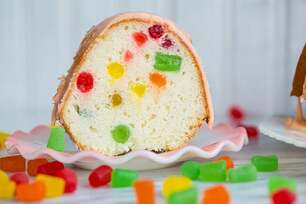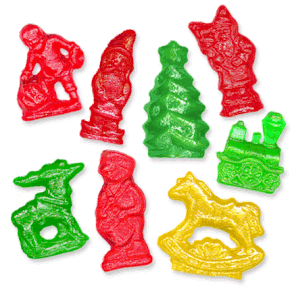My elderly aunt, living in the Maritimes, reminisced when Christmas in the 1930s was simple. And tasty. As I licked my lips, she listed off the goodies I’d only read about: gumdrop cake, barley sugar, ribbon candy, mincemeat tarts.

“Gumdrop cake?” I asked. “Never heard of it!” Although it did sound delightfully sinful.
Turns out gumdrop cake is still very popular Down East in Canada. You can create homemade gumdrops with unflavoured gelatin, lots of sugar, and flavour extracts. But the process takes time…a rare commodity in today’s fast-paced world. So, buy the gumdrops. Then add these colourful edible jewels to a butter pound cake recipe and voilà...gumdrop cake. Beautiful to look at. Fun to eat.
“Gumdrop cake was always a treat in our house at Christmas. Mum made it every year,” remembers my aunt.

According to Smithsonian Magazine and my aunt, a favourite holiday treat in Victorian times was barley sugar/candy. I guess we humans started eating cereal grains tens of thousands of years earlier than first thought. We began eating refined sugar about 5,000 B.C.
A couple of centuries later, a lightbulb flashed in some creative sweet-loving brain: if you combine barley and sugar the result is an ever so sweet candy.
Beginning in the 18th century, candy makers used metal molds to create colourful, remarkably detailed candy toys of barley sugar.
My aunt says she and her sisters looked forward each Christmas morning to opening their long, nylon stockings stuffed with precious goodies. “I remember those candy barley toys so well. Perfect in detail. Almost didn’t wanna eat ‘em. We’d suck ‘em so they’d last longer.”

Ribbon candy was another of my aunt’s favourites.
Ribbon candy is a traditional Yule sweet that traces its roots back centuries to Europe. Its historical evolution, however, remains fuzzy.
At first candy makers/bakers developed the sweet ribbons as Christmas decorations for their shops. Each wavy ribbon was formed around the candy maker’s thumb until the 1800s.
That’s when mechanical crimpers were invented to shape the ribbons. Finger-like crimpers simulated the curl originally put into the candy by hand. While one candy maker made the candy, another spun off a ribbon shape feeding it into a hand-turned crimper. The curly ribbon then slid down a small conveyor where another worker, waiting with scissors, snipped the right length.
Too much work!
Obviously, this method to produce ribbon candy was labour intensive.
Until the 1940s ribbon candy was never made on a large scale; production
required more sophisticated equipment. Eventually, a single spinning roll was developed. By careful tending of the candy batch---and eliminating the hand spinner--- the automated machine could run faster. Trouble was a big bottleneck developed when hand-cutting the candy with scissors.
Finally, Sevigny Candy of Hanover, MA invented an air activated automatic cutter. And it’s still in use today by F.B. Washburn Candy.

The name sounds gross! That’s because the earliest versions of mincemeat were exactly that: minced morsels of meat. “But,” claims my aunt, “it isn’t Christmas if you don’t have mincemeat tarts!”
During the 12th century the introduction of new preservatives like sugar (honey/maple syrup), alcohol/vinegars and East Asian spices helped inhibit bacterial growth in minced meat, eliminating the need for salting or smoking. We can thank the Crusaders who returned to England from wars in the Far East. They brought spices, like cinnamon, nutmeg and cloves, for use in meat preservation.
Although the name remains, most modern-day versions of mincemeat contain various dried and/or fresh fruits suitably soaked in alcohol (like rum or brandy) along with exotic spices. And you can include minced meat as well.
So maybe, despite your crazy schedule, you might like to try your hand at one of these traditional treats this Christmas.
Then again, maybe you’ll only have time to visit your local big box superstore where everything is pre-baked. Like me.
 RSS Feed
RSS Feed